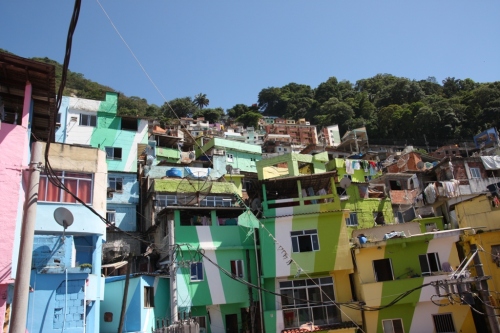Each day our students will blog about some of their experiences on the Brazil Travel Course. Our entry for Wednesday, 1/25 comes from Ondrej Skorpil.

It was impossible to skip a trip to a favela after seeing the City of Men film. Doug Tuggle, Tamara Stone, Kim Bowman, Petr Vostry and I signed up for the trip on Wednesday, i.e. our departure date. Although our tour guide Pablo warned us that the Jeep might not arrive on time, it actually did. We received a warm welcome by Linda, a true Carioca and – as it turned out pretty soon – the Jeep’s GPS navigation.
Along with us went an elderly Finnish couple and a young German couple. Their English, much to my surprise, was rather limited, so the entire conversation took place between us Chapman folks and our Carioca guide, Linda. Even before reaching the Dona Marta (also known as Santa Marta) favela, we learned a lot about the Brazilian nature from this elderly, charming, talkative and open woman. For example, while Brazilians love soccer, they are virtually unfamiliar with ice hockey. Much like other Latin Americans, Brazilians keep postponing the delivery of particular projects till the ultimate deadline, or perhaps a tiny little bit past the deadline. So while FIFA bosses are beginning to be slightly nervous about Rio’s unpreparedness for the 2014 world cup, the Cariocas are quite positive that things will somehow get accomplished in the end. Asked to explain the true meaning of the word Carioca, Linda happily answered that a Carioca is any person – man or woman – who is living a Rio life. Such a person might be American, Irish or Czech by origin, but if he or she moves to Rio de Janeiro and starts living by the Rio rules, he or she automatically becomes a Carioca. One practical piece of advice from Linda: should you wish to become a true Carioca, never stop at the red light after 9 p.m.!
After about a thirty-minute drive we finally reached the Dona Marta favela. Dona Marta had been “pacified” by the government of Brazil years ago, and was thus perfectly safe for us to walk through. The “pacification” process, we learned, is a fairly tough one. The government basically starts by sending in the army with tanks and soldiers equipped with automatic weapons to clean the favela from drug lords and mafia bosses. Subsequently it installs a police peace corps station within the favela to maintain the law and order on a permanent basis. Earlier attempts to solve the favela problem included the government tearing down three entire favelas and moving their inhabitants to the so-called City of God. This approach, however, brought about serious problems because the favelados did not have enough job opportunities in or near the city and both inbound and outbound transportation was extremely poor.

In Dona Marta we saw smiling, happy favelados living in poor conditions as measured by western standards. All children we have seen were perfectly clean and dressed in modern cloths. (One can have serious doubts if their Nike and Adidas t-shirts were really manufactured by the respective companies, but then – the “Rolex” watches I was offered on a downtown New York City street several weeks ago were apparent fakes too, and no one seemed to care about it too much.)
After a while, we reached the terrace where Michael Jackson shot his famous They Don’t Care About Us video clip in 1996. A gentleman who was showing us the clip in a nearby store was visibly proud each time his favela appeared in the video. No wonder Michael’s statue occupies an honorable space on the terrace and apparently is a popular meeting point for favelados as well as visitors.
People of Dona Marta do not own the land, but they did get an official title to their once illegally built houses. This presents a key advantage for them because houses can nowadays be freely sold and bought. This is practically demonstrated by favelados selling their rooftops to people who build an extra storey atop the current structure.
We were interested to know if a favela inhabitant is likely to move out to a better house when he or she gets a well-paying job that moves him or her to the middle class. Linda explained that this happens very rarely because favelados typically create very strong ties with their neighbors or other family members living in the same favela. Unless the whole family or clan could move out to a better place, an individual would not break his or her relationships and would in most cases opt to stay in the favela with his or her significant others.
The trip to Dona Marta was a wonderful and unique experience of Rio right before heading back to California. As far as I am concerned, a favela trip is a must-see for everyone who wishes to discover Rio de Janeiro off the beaten track.
In the evening we were literally appalled by the extremely low quality of the Rio de Janeiro Galeão-Antonio Carlos Jobim International Airport. An outdated facility in an apparent need of a major refurbishment is not something one would expect in a city of 6.3 million people that should be getting ready to host the 2014 FIFA World Cup and the 2016 Summer Olympics. No English speaking staff at the kiosks and very rude sales clerks only underlined our overall negative impression. Hours later we found out about two high-rises in downtown Rio collapsing causing at least four people to die while two dozen were still missing. Rio is, without a doubt, a breath-taking city. However, it still has to take a long journey to transform itself into a truly vibrant metropolis that is safe and enjoyable for everyone and capable of hosting first-class international events.
– Ondrej

